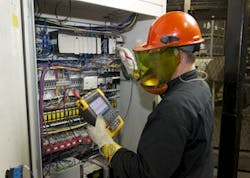Headquartered in Guelph, a small city just west of Toronto, Linamar is a multibillion dollar corporation and the second largest auto-parts maker in Canada. Linamar’s focus is precision machining, and among its many products are the engine blocks for the Dodge Viper and Chevrolet Corvette.
Keeping Linimar's 60 global facilities up and running safely and efficiently, including 25 in Guelph where many of the motors and transmissions are machined, is one of the responsibilities of the team led by Leigh Copp, engineering and business unit manager for Linamar’s Advanced System Group.
Copp manages a team of 72 people that design and engineer automation systems, and troubleshoot electrical systems and electronics as well as process controls and command and control systems. Inherent in that role is a commitment to safety and continuous evaluation of all the systems in the plants.
A recent project awarded to Copp’s team involved reducing the risk of arc flash from incident energy at one of Linamar’s facilities. “Like probably every other manufacturer of our size and station in our market, we’ve got between, 3,000 and 5,000 kVA distribution boards in our plants,” says Copp. The problem was that some of the standard switch gear and vented panels weren’t arc resistant, and therefore posed a significant risk to safety.
“In Canada we’re predominantly 600 volts, with a 3,000 to 5,000 kVA transformer outside and a 5,000 amp busway coming into a 5,000 amp switchboard,” states Copp. “The arc flash incident energy is five times the old Category 4 boundaries, so there is no suitable PPE available. We were pretty concerned, and we started looking at alternatives on how we can improve the situation.”
In one event signaling the problem, a seal had failed in an outdoor panel, and rainwater dripped into the enclosure, gradually filling it up until the busbar failed and blew apart. “It was outdoors and nobody was around, but it literally was no different than if I’d put a hand grenade inside the panel,” Copp remembers.
When working among electrical panels in high-energy incident areas or working on proactive maintenance like Linamar’s arc-flash risk mitigation project, Copp and his team deploy Fluke Connect Assets, a cloud-based system of software and wireless-enabled test tools that moves all of the measurement data collected by the tools into an online database and dashboard.
Copp calls these tools “a game changer” when it comes to high-voltage work because it removes technicians from dangerous energized areas and records real-time data while associating those data with specific assets. For example, three-phase motors used throughout the facility can be monitored while in use after hooking up wireless clamp meters. Copp uses the Fluke AC and DC clamps equipped with iFlex devices with the Fluke Connect app on his Android phone.
“I would put the instruments on, close the door, start the machine up, link them to my phone, and then go around to the front of the machine and actually monitor the voltage and current while the machine’s operating with the door is closed completely safely," says Copp.
In the case of the arc-flash mitigation project, Copp's team performed a complete analysis of the system and learned that the high-incident energy potential was between 190-212 calories per square centimeter – four to five times above the acceptable safety threshold for the heaviest class of PPE typically available, and well above what was considered high risk.
In response, the Linamar team designed and installed a high-voltage protection system around the feeder lines coming into the plant. The new equipment brings incident energy levels down to a category 2 or 3 using the old category ratings, or to a level where there is practical PPE available to protect maintenance workers.
The Fluke Connect system is a growing number of wirelessly connected test and measurement tools that leverages Bluetooth Low Energy (BLE) technology, industrial networking, and cloud computing in an integrated test and measurement platform.
"Previously what we've done (to collect asset data) is to use paper service reports with good old-fashioned carbon copies, and I would ask the better technicians of the team to, for example, record the capacitance and insulation resistance readings when they were testing a capacitor or transformer,” says Copp. “Now, it's pretty cumbersome to record a time-resistance curve, which is a very useful piece of PdM data. Fluke Connect Assets will allow you to pull that curve automatically using the Fluke 1587 FC Insulation Multimeter. You can absolutely record those spot measurements and associate them with the asset."
[sidebar id="5"]
Another advantage of an app such as Fluke Connect is the ability to collect all the data from multiple tools in one place. The data is logged by date and equipment and can be shared easily – a reduction in the burden of data-keeping that Copp recognizes as a clear win for Linamar.
"The problem with paper service reports is, where are those reports filed?" he asks. "They might get scanned, or maybe they get saved with the asset depending if it's one that we built or not, but typically it's an asset that we don't have a record of because it's somebody else's. In one instance, the person in charge of logging those data service reports was transferred to another facility, and their role was not backfilled. The potential exists for Fluke Connect Assets to perform that function and record that data, so we can go back and review the history on a given asset."
However, Copp sees the biggest benefits of using wireless data collection tools as both safety and ease of measurement enabled by the technology. He cites the Fluke 1738 Power Logger with WiFi capabilities as a tool designed for more in situ, semi-permanent, condition-based monitoring. "We're using that tool to perform remote checks," says Copp. "You can put it up on a bus duct, so you don't have to use a scissor-lift every time," reducing safety risk with the ability to monitor the asset over the wireless network infrastructure.
Copp also finds that the Fluke platform also helps him balance the competing budgetary demands of reducing total cost of ownership while optimizing daily operating cost-efficiency. "Fluke Connect Assets can actually answer both problems: I can make sure the team is working more efficiently because they've got access to data on similar assets, and I'm storing the data without additional paperwork, so that's an immediate improvement of efficiency. And on a TCO level, the faster I can fix an asset, and the less often I have to fix it, that pays huge dividends in reducing downtime."
Ultimately, it may simply be the power of collaboration that will drive wider adoption of wireless data collection tools. "One of the things that's changed in our team dynamic is that we don't have the luxury of people with 20 years' experience on every job, all the time," Copp says. "We've got people from ages 17 to 65 on our team, and how do you share your knowledge and experience with them efficiently? Giving this technology to a larger team, they become kind of a hive mind; they can share the data, share their experience, and share their observations more seamlessly so they can consult on the problem and solve it faster."



